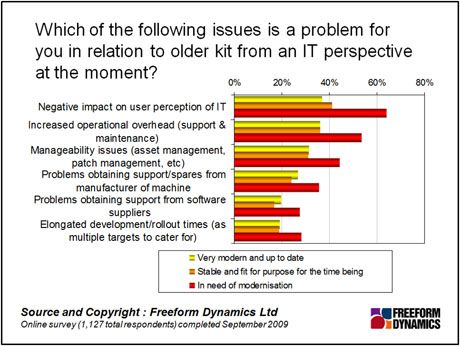Here’s a direct question on this (hopefully sunny) day. Do you, or does anyone in your organisation, know precisely how much money you spend on PC support?
In principle, this sounds straightforward enough to answer – after all, isn’t it just about the desktops and laptops, and the software they run? But in our travels we have come across very few organisations that have a really good handle on PC support spend.
For a start, PC support is often lumped in with everything else – application support, network support and so on. And second, the mechanisms in place may be complex and difficult to prise apart – internal staffing costs, second-and third-level expertise, maintenance contracts with specific organisations and call-off arrangements with others, all add to the mix.
Also, we have the question of tooling. We know from various research studies that help desk tools are fair-to-middling in supporting desktop support activities. Problem logging, trouble ticketing and so on may be in reasonable shape, but the financial aspects of support is one area that remains lacking. This is chicken-and-egg – the lack of such information in the first place, makes it difficult for any toolset to claim it can provide any real visibility on PC support costs.
For all of these reasons and more, many organisations may choose to let sleeping dogs lie, to measure cost at the ‘big bucket level’ rather than isolating desktop support costs from everything else. We can think of a number of reasons why this is a bad idea: first that a lack of visibility on costs can obscure the picture of whether things are working fine, or if they are past their sell-by date.
As we know from our recent research, there is a ‘tipping point’ relating to older kit and technical issues – as illustrated by the chart below. Here we’ve cut two questions from a recent desktop survey against each other – first, asking what issues existed from an IT perspective, and second, the up-to-date-ness of the desktop estate.

The lesson here is that once the estate slides into obsolescence, issues become more prominent, and many are only one step away from this (“Fit for purpose for the time being”).
As you can see, there’s little between the first two groups that consider their IT environments to be either ‘fit for purpose for the time being’ or ‘in need of modernisation’. The third group seed significantly more problems across the board – that’s the red bar.
So, somewhere between the desktop estate being perceived as fit for purpose, and in need of modernisation, lies the point where costs suddenly accelerate in terms of both manageability and user productivity. Without clear visibility on cost, however, it becomes very difficult to know when this point is reached.
The second reason for getting a handle on desktop costs, is that otherwise you won’t be able to know what difference any changes can make. We could cite all kinds of potential improvements – decent service management processes for example, a clearer view over desktop assets, better use of tools and so on. But all such things have an associated cost of their own and without understanding the current state of play, it’s going to be hard to decide where to make improvements.
All the same, while it might be difficult to get a handle on costs, don’t let that put you off. There is ample evidence to suggest scope to improve the desktop support function, and while you might not have a clear picture of your own costs, the benefits remain pretty compelling.
Through our research and insights, we help bridge the gap between technology buyers and sellers.



Have You Read This?
Generative AI Checkpoint
From Barcode Scanning to Smart Data Capture
Beyond the Barcode: Smart Data Capture
The Evolving Role of Converged Infrastructure in Modern IT
Evaluating the Potential of Hyper-Converged Storage
Kubernetes as an enterprise multi-cloud enabler
A CX perspective on the Contact Centre
Automation of SAP Master Data Management